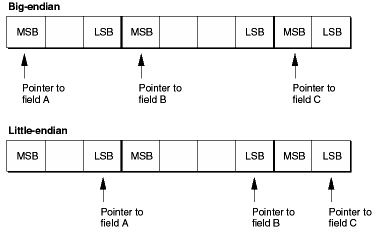PATH
There are two ways that multibyte data fields may be addressed: big-endian addressing, where the address for the field refers to its most significant byte, and little-endian addressing, where the address for the field refers to its least significant byte.
These two types of data organization are illustrated in Figure 2-1, which shows a region of memory containing successive fields that are 3, 4, and 2 bytes long. MSB and LSB indicate the most significant and least significant bytes in each field, respectively.
Figure 2-1 Big-endian and little-endian addressing

Since data fields are normally stored in RAM by writing from lower to higher addresses, big-endian addressing also means that the field's lowest address in physical memory contains its most significant byte; little-endian addressing means that the field's lowest address contains its least significant byte.
If the Macintosh system always wrote and read multibyte data fields in one operation, it wouldn't matter whether the fields were addressed in big-endian or little-endian mode. For example, if the hardware always transferred an 8-byte field in a single transaction, using 64 bit-lines, it would be immaterial whether the location of the field were defined by referencing its most significant byte or its least significant byte. But when data fields are transferred over buses of limited width, they must often be divided into subfields that fit the capacity of the bus. For a more detailed discussion of endian issues, see Big-Endian and Little-Endian Addressing.